Das Zurücksetzen Ihres WordPress-Passworts ist normalerweise ein unkomplizierter Vorgang. Manchmal funktionieren die Standardmethoden jedoch nicht, sodass Sie von Ihrer Website ausgesperrt werden.
Einige unserer Besucher sind auf dieses Problem gestoßen und haben uns um Rat gefragt, wie sie am besten auf ihre Konten zugreifen können. Glücklicherweise können Sie das Werkzeug phpMyAdmin im Control Panel Ihres Hosting-Kontos verwenden, um Ihr Passwort direkt in der WordPress-Datenbank zurückzusetzen.
In diesem Artikel zeigen wir Ihnen, wie Sie ein WordPress-Passwort ganz einfach über phpMyAdmin zurücksetzen können. Wir erklären jeden Schritt genau, damit Sie auch dann sicher folgen können, wenn Sie sich nicht mit Datenbanken auskennen.
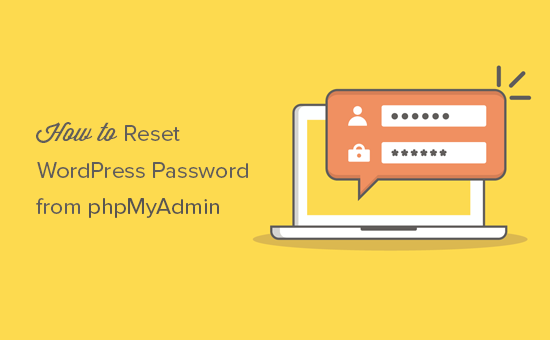
Warum ein WordPress-Passwort von phpMyAdmin aus zurücksetzen?
WordPress macht es super einfach, ein verlorenes Passwort wiederherzustellen.
Gehen Sie einfach zum Anmeldebildschirm Ihrer WordPress-Website und klicken Sie auf den Link “Passwort vergessen?”.
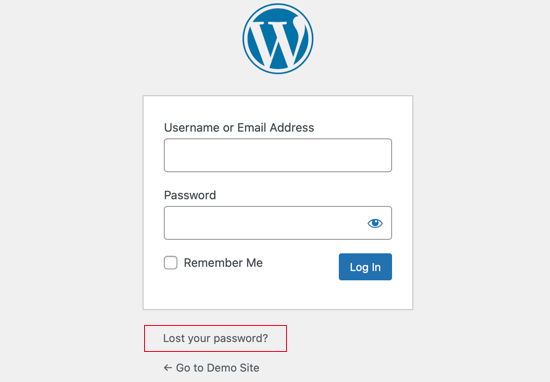
Wenn Sie auf den Link klicken, werden Sie auf die Seite zum Zurücksetzen des Passworts weitergeleitet. Sobald Sie Ihren Benutzernamen oder Ihre E-Mail-Adresse eingeben, sendet WordPress einen Link zum Zurücksetzen des Passworts an die entsprechende E-Mail-Adresse.
Wenn Sie jedoch keinen Zugriff auf diese E-Mail-Adresse haben oder Ihre WordPress-Website keine E-Mail sendet, können Sie Ihr Passwort nicht zurücksetzen.
In einer solchen Situation müssen Sie Ihr WordPress-Passwort direkt in der Datenbank zurücksetzen. Am einfachsten geht das mit phpMyAdmin.
Sehen wir uns nun an, wie Sie ein WordPress-Passwort von phpMyAdmin aus zurücksetzen können.
Wie man ein WordPress-Passwort von phpMyAdmin aus zurücksetzt
Wenn Sie sich das Video-Tutorial nicht ansehen möchten, können Sie die Textversion weiter unten lesen.
Zunächst müssen Sie sich in das cPanel-Dashboard Ihres WordPress-Hosting-Kontos einloggen. Als nächstes müssen Sie zum Abschnitt Datenbanken navigieren, wo Sie auf das Symbol phpMyAdmin klicken können.
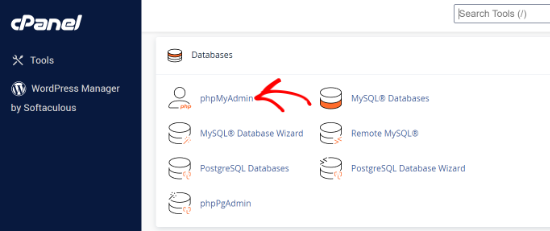
Dadurch wird die phpMyAdmin-Anwendung gestartet.
Hier müssen Sie Ihre WordPress-Datenbank im linken Bereich auswählen.
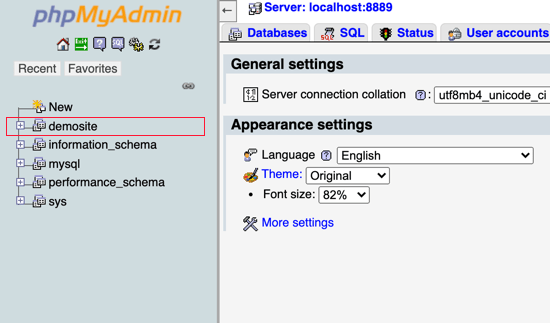
Sie sehen nun die Liste der Tabellen in Ihrer WordPress-Datenbank.
Suchen Sie in dieser Liste nach der Tabelle wp_users und klicken Sie auf den Link “Durchsuchen” daneben.
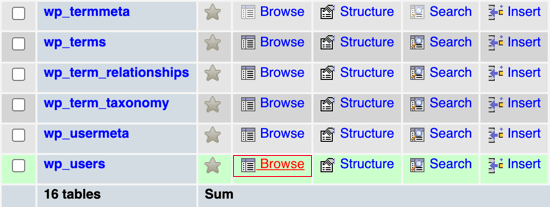
Hinweis: Die Tabellennamen in Ihrer WordPress-Datenbank haben möglicherweise ein anderes Präfix als das, das wir in unserem Bildschirmfoto zeigen. Das Ändern der Tabellenpräfixe kann die Sicherheit Ihrer WordPress-Website verbessern.
Sie sehen nun die Zeilen in Ihrer WordPress-Benutzertabelle. Klicken Sie auf die Schaltfläche Bearbeiten neben dem Benutzernamen, dessen Passwort Sie ändern möchten.
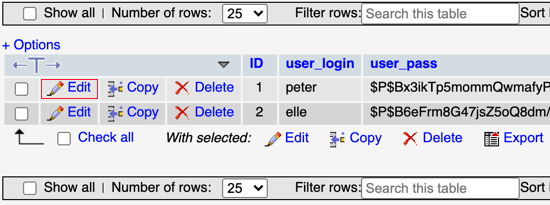
PhpMyAdmin zeigt Ihnen ein Formular mit allen Benutzerinformationsfeldern.
Sie müssen den Wert im Feld user_pass löschen und ihn durch Ihr neues Passwort ersetzen. Wählen Sie in der Spalte “Funktion” die Option “MD5” aus dem Dropdown-Menü und klicken Sie dann auf die Schaltfläche “Los” am unteren Rand des Formulars.
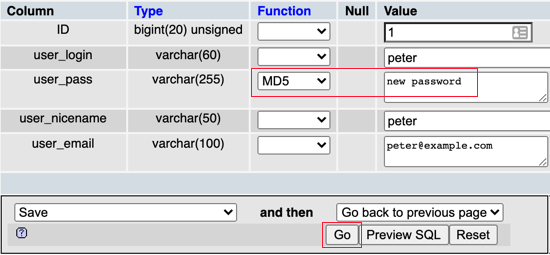
Ihr Passwort wird mit einem MD5-Hash verschlüsselt und in der Datenbank gespeichert.
Herzlichen Glückwunsch! Sie haben Ihr WordPress-Passwort mit phpMyAdmin erfolgreich geändert.
Einige von Ihnen werden sich vielleicht fragen, warum wir den MD5-Hash für die Verschlüsselung des Passworts gewählt haben. WordPress hat früher MD5-Hash zur Verschlüsselung von Passwörtern verwendet, aber seit WordPress 2.5 werden stärkere Verschlüsselungstechnologien eingesetzt.
WordPress erkennt jedoch weiterhin MD5, um Abwärtskompatibilität zu gewährleisten. Sobald Sie sich mit einer als MD5-Hash gespeicherten Kennwortzeichenfolge anmelden, ändert WordPress diese automatisch, um die neueren Verschlüsselungsalgorithmen zu verwenden.
Expertenanleitungen zu Passwörtern in WordPress
Nachdem Sie nun wissen, wie Sie ein WordPress-Passwort über phpMyAdmin zurücksetzen können, möchten Sie vielleicht noch einige andere Artikel zum Thema Passwörter in WordPress lesen.
- Wie Sie Ihr Passwort in WordPress ändern (Anleitung für Anfänger)
- Passwörter für alle Benutzer in WordPress zurücksetzen
- Anpassen der WordPress-Seite “Passwort zurücksetzen
- Wie man Benutzer dazu zwingt, Passwörter in WordPress zu ändern – Passwort ablaufen lassen
- Passwort vergessen? Wie man ein verlorenes Passwort in WordPress wiederherstellt
- Erzwingen starker Passwörter für Benutzer in WordPress
- Hinzufügen der Zwei-Faktor-Authentifizierung in WordPress (kostenlose Methode)
- Verstecken/Anzeigen von Passwörtern auf dem WordPress-Anmeldebildschirm zulassen
- Einfache und sichere Verwaltung von Passwörtern (Anleitung für Anfänger)
Wir hoffen, dass diese Anleitung Ihnen geholfen hat, zu lernen, wie man ein WordPress-Passwort über phpMyAdmin zurücksetzt. Vielleicht interessiert Sie auch unser ultimativer Schritt-für-Schritt-Leitfaden für WordPress-Sicherheit, um Ihre WordPress-Website sicher zu halten, oder unsere Expertenauswahl an Must-Have-Plugins.
Wenn Ihnen dieser Artikel gefallen hat, dann abonnieren Sie bitte unseren YouTube-Kanal für WordPress-Videotutorials. Sie können uns auch auf Twitter und Facebook finden.





Bowen
Hello,
Added Https to all pages, says unsafe, attempt to login and no luck, hit forgot password system reverts to Mojo Page…changed password per instructions above still no luck…any ideas how to get https off wordpress?
Tess
OK, I have followed these instructions and successfully changed my admin password in the database and I still get a failed login message when I login with it. I need help gaining access to my site, please.
Sandra
Thank you so much! These instructions helped me reset my WP username and password
neotanvir
How can I transfer MD5 to normal text
Patty Ayers
Thank you! Worked like a charm.
Edwin Schichter
Very simpel…. just change and save the users emailadress into something familiar in the database, click on forgot password in the wordpress login page
Patty Ayers
Yes, but only if you already have access to the back end.
Andrew
Awesome thanks so much for taking the time to write this just recovered by site in 60 seconds – as a newbie rely on help online :)))
Yana
Thanks mate, you made my day =)
Kinfe Weldu
thank you.this solved my problem.
sarah
thanks very helpful
Toyin
Thanks for this article.Simple guide,was able to change my password through myphp.
harish chand
Great thanks
MITESH MISTRI
Hey… Nice post and this idea really works. Thanks.
Adeel Ahmed
Thanks a lot. I had the problem but it has been solved . Otherwise I felt miserable about my wordpress login password being stolen
Jedediah
Odd, I did this correctly and it’s still not letting me in.
venukanth
really thanke ..most use full
Hasan
Thanks, it’s really helpful and great !!
Razzaq
another simple method for get the password, after edit the record change the email address. On wp-admin login screen, click on forget password. You will get the new link of make a new password.
Harsh
Thanks a lot friend, very helpful post
Asaf Fialkov
Many thanks! Worked like a charm
Mike
Fantastic, you are geniuses!
Ken
Thanks Man, your a lifesaver
Dave
Perfect. Thanks for posting.
VaLAngel
Great, great, great! 1 Billion Thanks…
Clinton
Thank you!
Al
Thanks buddy, i used to do lots of stuff on my wordress blog few years ago but now i kind of forget how to do it. Your blog post refreshed my memory…thanks again
Jarrii
Thank you so much It works perfectly
It works perfectly 
Hilda
worked perfectly, thank you so much!
Dan
Followed your very clear steps. Worked like a charm. THANK YOU!
Rose
Thank you so much! I couldn’t get into my new install of Word Press and of course it is the weekend. This is so well written that I was able to reset the admin password in one try.
Ewan
How is this discussion affected by the salts in the wp-config file? Do we need to combine those when creating a new password?
Marty
Over the last few weeks, I’ve had the pleasure of dealing with clients that didn’t have a reputable developer/designer and left them high and dry with little to no access of their OWN site, noway of re-setting the password through the recovery email, this guide WOULD have been great 2 weeks ago, but I’m sure I’ll be using it in the near future…
cheers Syed..
Karl Craig-West
Perfect, worked a treat.
Many thanks indeed.
Harpa
Thank you so much
Dotty
Thanks so much – this really helped.
Luis
What a lifesaver post! Thanks!
Ton
Thank you so very much!
Andrea
ok, I have done step by step everything you have suggested and is not working……..what can I do?
Editorial Staff
Theoretically, if you did everything mentioned in this article, then it should work. However, you can always try this tutorial where you add a new admin user.
https://www.wpbeginner.com/wp-tutorials/how-to-add-an-admin-user-to-the-wordpress-database-via-mysql/
Admin
Marty
You can lead a horse to water………..but…..!…..
BK
This was a life save. thanks
vking
thanks you man it’s work!
it’s work!
Muhammad Abdul Qadoos
why not we change email address and ask wp to resend password reset email
we change email address and ask wp to resend password reset email 
Editorial Staff
You can do that as well. Then go click on reset button. Wait for the email to come. Then reset your password. Seems like a bit longer process, but to each their own.
Admin
subbareddy
this helps very much when you are in local system . Password reset doesnt work some times in local server .
I helped me a lot today
Benjamin
Some hosts have the mail() function turned off and are unable to send emails via php.
stevelockridge
Fabulous!!! Thank you!!! My client contacted me because their previous designer vanished and left them with NO login information for ANYTHING. This saved us all a lot of headaches.
rradvani
great saved me !!! thanks wpbeginner!!
!!! thanks wpbeginner!!
sharphue
See that user_email field in the screenshot above? Just change the value to an e-mail address that you have access to. On the WP-Admin login screen, click “lost your password?” and type in the same e-mail address and you will receive a reset password link that will be easier than messing with MD5 hashing.
Oluniyi D. Ajao
Thank you very much. You saved me having to re-install a WordPress installation.
W^L+
There has been some talk about web applications moving to a hash of the password + another string, to make it harder for bad guys to get in. Do you think this is coming to WP soon? (I think Joomla and Drupal are already doing this.)
Editorial Staff
WordPress already has that built-in. You just have to add your own security keys in your wp-config.php file. Open it and you will see the place for it and a link where you can get your security keys from.
Admin
Jeff
Under the functions column, if you choose MD5, MySQl will automatically encrypt your password in MD5. Simply type your plaintext password in the main box.
This is a little easier than using other sites.
kusanagi
very helpful, thanks.
Utkarsh
You can also enter the password in plain text, and select MD5 from the function dropdown. It’ll automatically save the MD5 hash of the password in the database.
Jaspal
Thnx .. that’s a great tip .. it will be very helpful for me